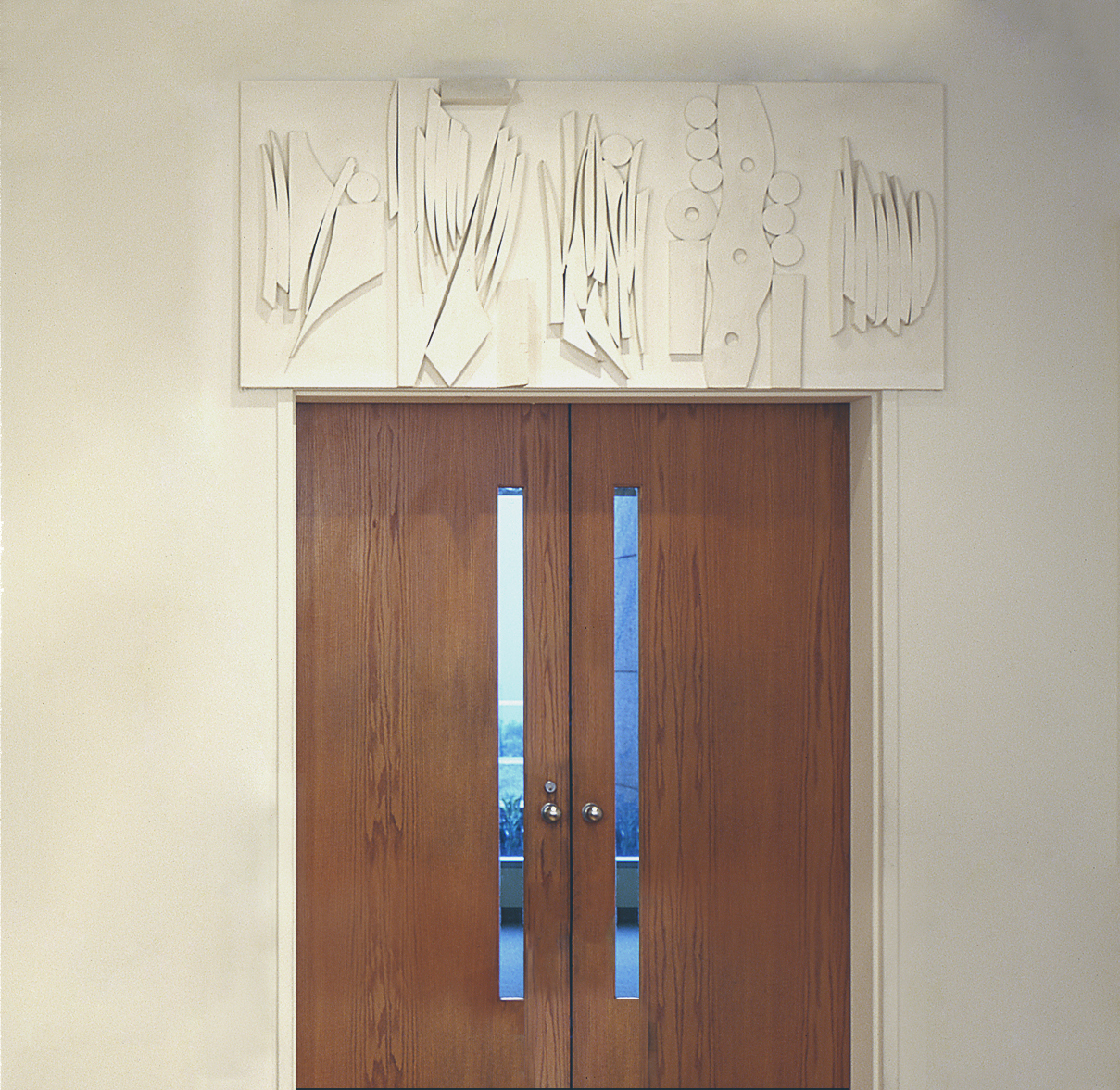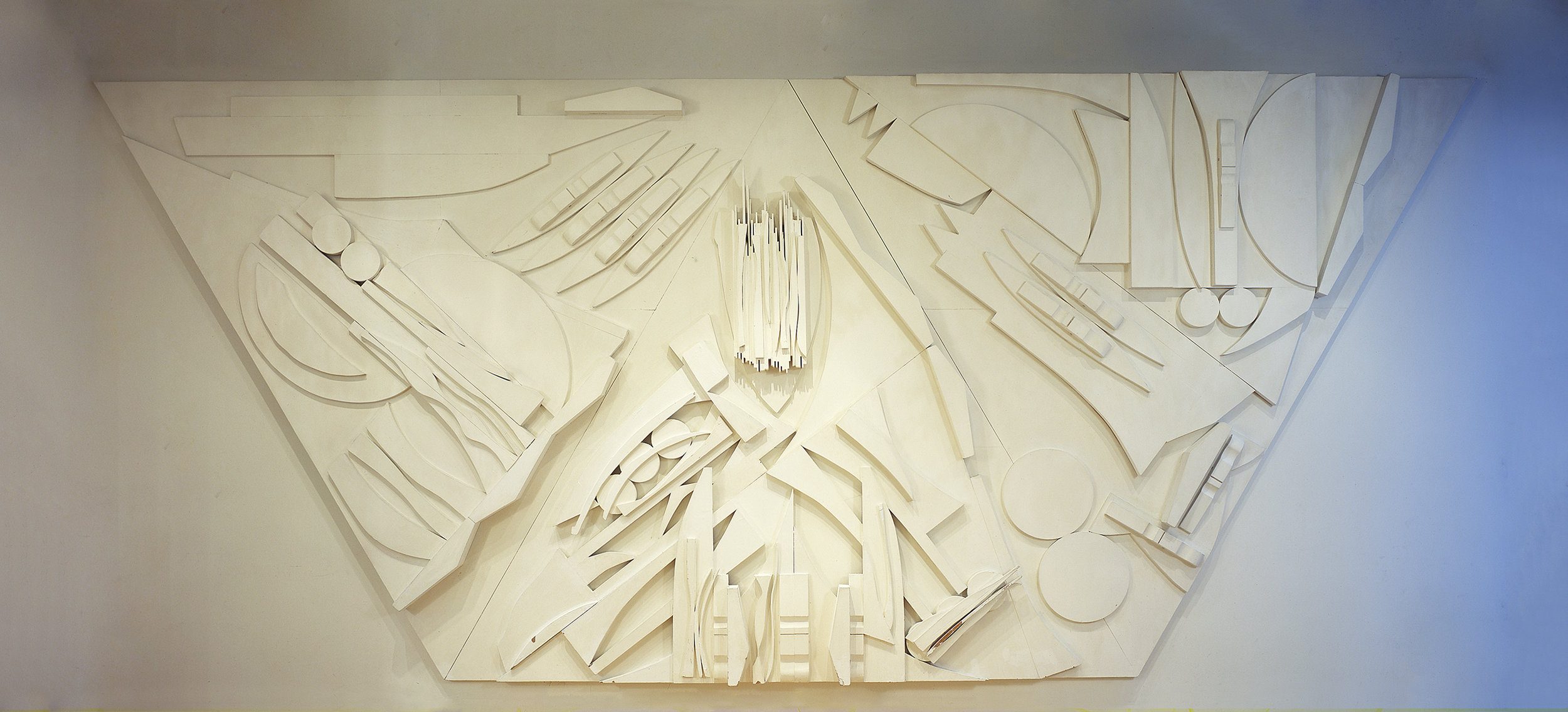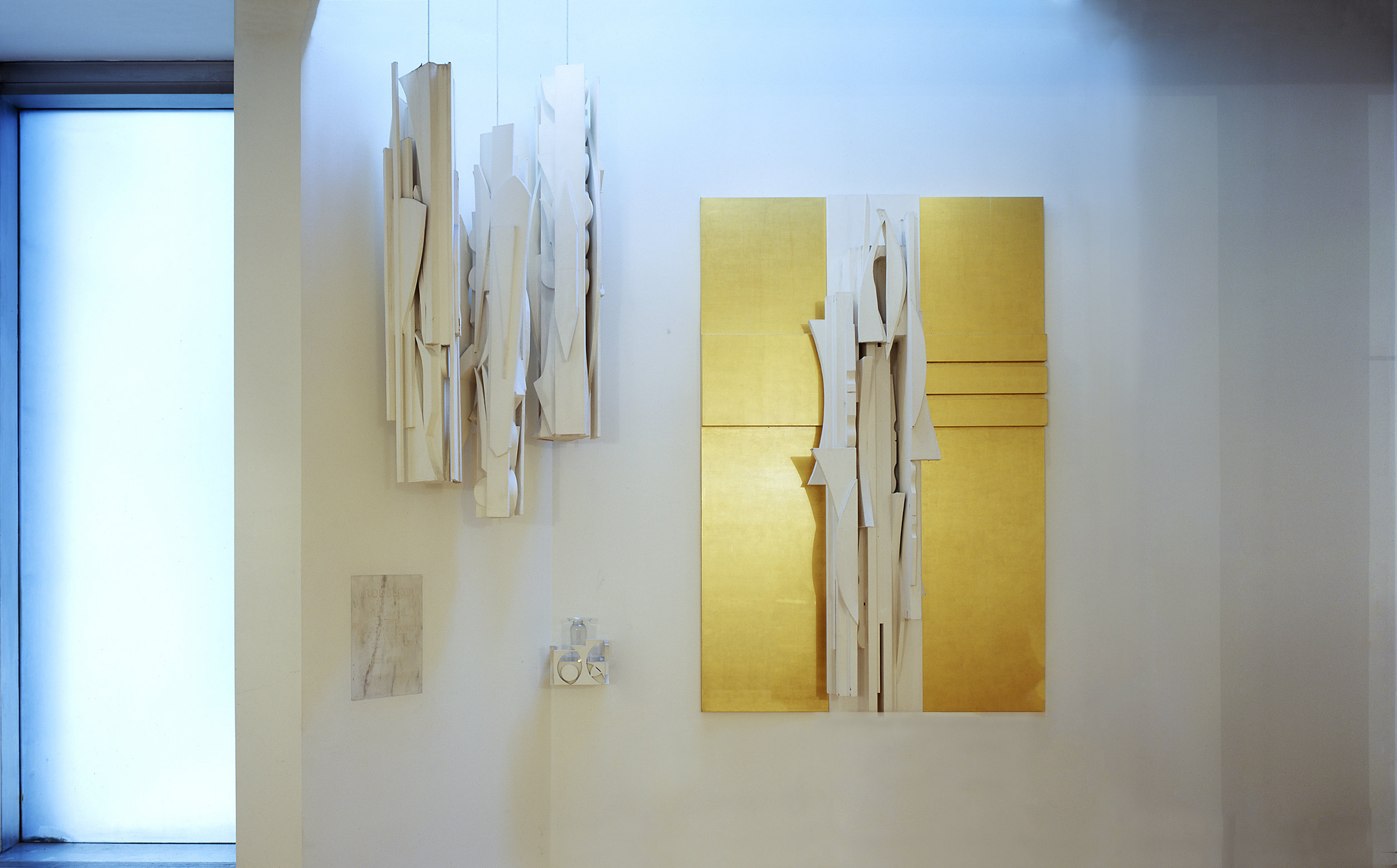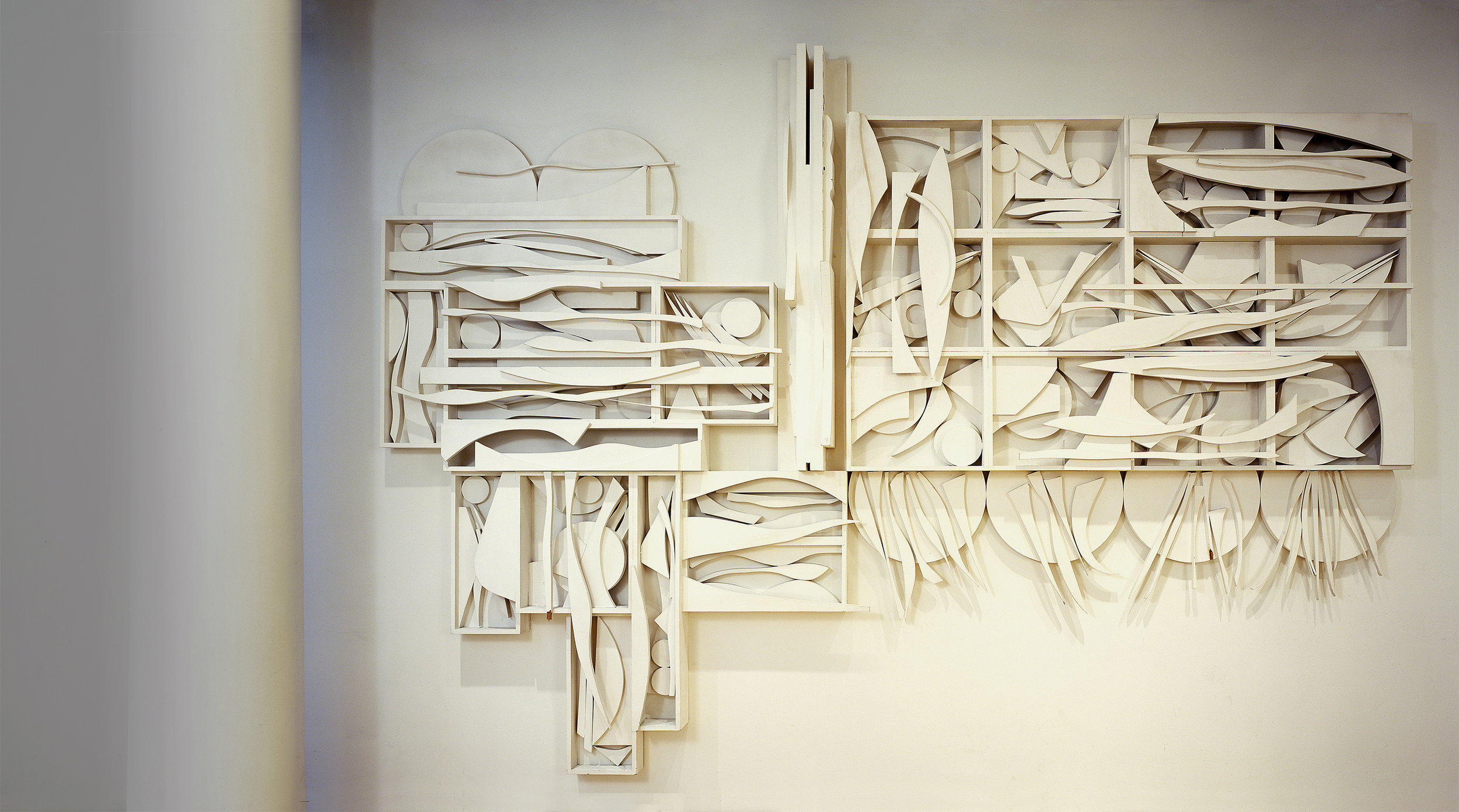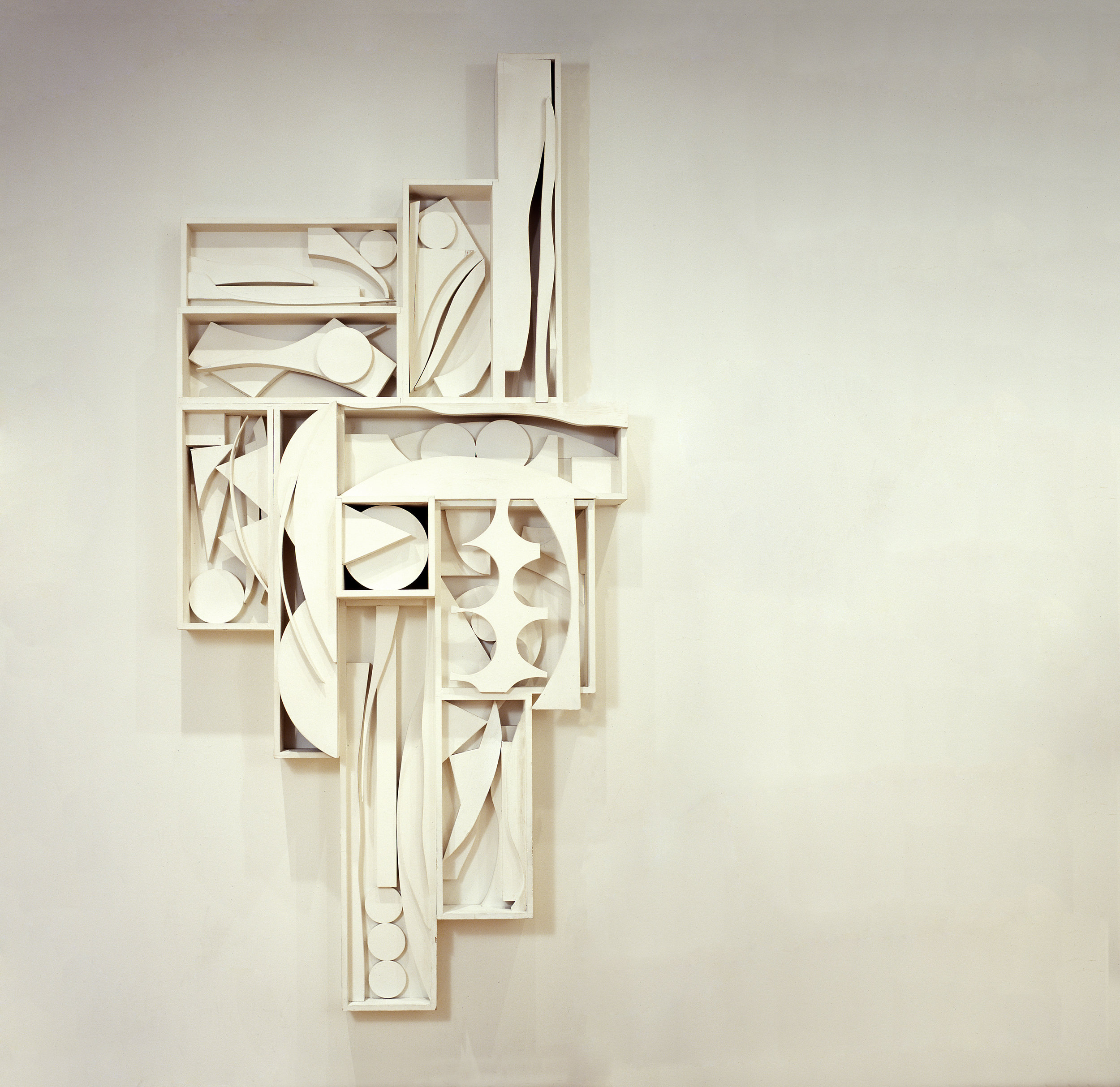
Nevelson
Chapel
To enter Louise Nevelson’s intimate, calm, engaging vision of a chapel at the base of a towering corporate skyscraper is to find both respite and revelation. Her installation here is not just a place, it is an experience; an experience that is harmoniously contained, yet uncontainable; profoundly and marvelously human. Visitors to this installation will tell you: more than an extraordinary work of art, Nevelson Chapel is deeply spiritual—a catalyst for transformation.
You can rebuild alongside Nevelson, reclaiming the promise of this time and place as it was imagined 40 years ago. Each generation has the opportunity to leave a legacy, Nevelson offers a way to connect across generations to reclaim hope deferred. Nevelson called it her “gift to the Universe.” Now it is a gift you can also give.
Louise
Nevelson
Louise Nevelson carved a place for herself in the annals of art history with her breakthrough sculptural environments—installations that invite the viewer into a comprehensive experience within and among several sculptural elements. Her early sculptural environments (such as Moon Garden + One and Dawn’s Wedding Feast) were groundbreaking in the mid-20th century, and have since inspired generations of artists.
Gathering her material from the castoffs of everyday life—chair legs, cabinet doors, scraps of wood, and other quotidian “detritus”—Nevelson constructed an utterly unique view of the world that was strangely evocative of the unknown, yet instantly familiar.
Nevelson biographer, Laurie Wilson, speaks of a parallel between Nevelson’s childhood—fleeing the pogroms of her native Ukraine, experiencing as a Jewish refugee a sense of being discarded and unmoored herself—and her affinity for the castaway items that found their way into her works from the sidewalks and dustbins of New York. From that early experience of disenfranchisement, Nevelson came to claim a unique place in the art world and in her beloved New York City.
By the 1970s, Nevelson had captured the imagination and respect of the art community around the world. When Saint Peter’s approached her with the idea of a chapel that would be a place of quiet in the city, Nevelson was immediately intrigued. For Nevelson, the chapel would be “a holy place,” “a place for all people.” To her, there was “no distinction between a church and a synagogue. If you go deep enough into any religion you arrive at the same point of harmony.”
Nevelson’s sensibilities, her approach, and her undying belief in the spirit of New York were the ideal alchemy for accomplishing the vision of a chapel that would become the City’s oasis.
Working onsite to ensure that every element would be fully integrated, Nevelson created what she would come to call Chapel of the Good Shepherd, a work of nine substantial white and gold-leaf sculptures. This is the quintessential expression of Nevelson’s mastery—her grasp of how simple, familiar shapes and contours can touch the deeply-held memories and aspirations of the human spirit; her appreciation for the interplay of light and shadow, and her restraint in allowing these influences sufficient space within her own artistic vision.
Remarkable in its ability both to embrace and to transport the viewer, Nevelson Chapel provides a quietly dramatic counterpoint to the busyness of city life on the streets outside. And while other environments have been disassembled long ago, or are only available in temporary exhibitions, the Chapel remains—the artist’s only intact, comprehensive sculptural environment open and accessible to the public in its original permanent setting.
Now, Nevelson’s masterwork is in need of attention. Forty years on, it is a critical moment for the conservation of cultural heritage. Saint Peter’s has begun the multi-year process of reviving the artist’s original vision and ensuring that the Chapel lives on as Nevelson intended.
You are invited into a multi-phase campaign to renew and revitalize Nevelson Chapel, and with it her vision, ensuring that New York’s residents and visitors, students and artists, religious and non-religious pilgrims are welcomed and inspired by Nevelson for generations to come.
Saint Peter's
Church
Saint Peter’s is rich in history, iconic in architecture and design, inspired in liturgy and the arts, and dedicated to the life of the City.
To understand how and why Nevelson Chapel came to be in this place, you must also understand Saint Peter’s Church. Walk into Saint Peter’s on any given day, and you will find meals being served, activities provided; concerts, art, theatre, dance, and sacraments being offered; people rushing to and from work in the midst of the busyness of an eclectic urban existence. Yes, all in a church. Saint Peter’s commitment to serving its neighbors isn’t theoretical; it’s real and tangible.
Saint Peter’s began its mission in the loft of a rented grocery store in 1862, growing into a thriving congregation and constructing a traditional, Neo-Gothic church building in 1903. The church presided over its East Side neighborhood as it transitioned from a huddle of shops and modest homes to a high-rising commercial hub; then stalwartly faced the city’s decline from its vantage point at Lexington Avenue and 54th Street.
By the 1970s, New York City was facing bankruptcy. The neighborhood around Lexington and 54th Street was crumbling. The church that had stood in Neo-Gothic splendor in halcyon days, now found it had a choice to make. Other congregations were following their members to the greener pastures of New York’s many suburbs. Saint Peter’s chose to stay—and not just to stay, but to dig in and double down on its mission to the city that had called it into being.
Saint Peter’s chose new life: a life that proclaimed a “bold statement of Christianity’s confidence in the future of this city.” What others saw as encroaching darkness was for Saint Peter’s merely a prelude to the dawn of a deepening urban mission, a mission to be expressed through art, music, jazz, theatre, and serving those in need.
The Bible warns against putting new wine in old wineskins lest they burst. Saint Peter’s heeded that warning and took the bold, even radical step of reimagining what a future-facing church could look like; how it might contain the new life it envisioned. That vision was articulated in a brief entitled Life at the Intersection, and brought to fruition with pioneering architects Hugh Stubbins and W. Easley Hamner, designers Lella and Massimo Vignelli, in partnership the First National City Bank (which had also eschewed escape to the suburbs) and became the world-renowned architectural icon known as CitiCorp Center. A springboard of new life for a neighborhood now thriving and vibrant once again.
Friends of the church, and proponents of its revitalizing mission at that time, included such luminaries as Ruth and Duke Ellington, John Cage and Merce Cunningham, Edward Albee, Willem de Kooning, and Louise Nevelson. It was Nevelson, the internationally renowned sculptor, who would be asked to create what the church envisioned as its “tap root,” a “jewel,” a “tranquil place for peace, reflecting permanence”—a chapel to speak to the human soul in the heart of New York.
Nestled at the center of Saint Peter’s, Nevelson Chapel provides life-giving quiet and space to all who enter from the busy streets outside and office towers above. Saint Peter’s offers this gift to all, without distinction. The Chapel is an open heart that thrives with the life of visitors, entering full of whatever they carry from the outside world and stepping out again refreshed, renewed, re-centered for life in that world, just as Louise Nevelson intended.
Being and
Becoming
This moment in the life of Nevelson Chapel offers much more than a return to a glorious past. It is clear that the present and future of the Chapel are as significant and filled with potential as its inaugural moment. Not only unique among Nevelson’s publicly accessible intact works, Chapel Of the Good Shepherd is unique both as a work of modern art and as a chapel.
One of a handful of sacred spaces in the world conceived by great artists of the 20th century—Matisse, Rothko, and Nevelson—it is the only such space in New York City. Unique, too, in the context of religious spaces in New York City by virtue of its contrast to the vast and vaunted traditional chapels and cathedrals one associates with the City.
Our full vision for Nevelson Chapel is to extend its reach within and beyond its graceful walls, to an ever-wider audience. Simply by continuing to welcome the weary traveler, the hard-working New Yorker, the soul-searching stranger, the Chapel stays true to its purpose. Just as when its doors first opened, there is now and will always be a need for such a place as this, set apart from the relentless pace of city life, yet not remote from it.
By welcoming, supporting and encouraging emerging artists who venerate Nevelson and her colleagues as giants and guiding forces, we envision the Chapel as a source of artistic expression yet to come. Demonstrating a reverence for art provides inspiration for artists and ensures the future of art while honoring and preserving its past.
By recording and digitizing the restoration process in real time, we will create a shared experience that will serve art conservators and artists, as well as those who can envision their own healing concurrent with the Chapel’s repairs. In the chips, bubbles, wear and tear that mar the promised perfection of Nevelson Chapel, we can see ourselves. The common elements of our lives are showing the effects of destructive forces, and the fraying of neglect.
Now is the moment to find healing ourselves in the restoration and repair of this promise, to reclaim the legacy of hope, and rebuild the future from the heart that still beats at the intersection of Lexington Avenue and 54th Street.
When the restoration is complete, a fully integrated, technologically-enhanced experience will become possible. Global reach through remote access and augmented reality will allow those who might never physically enter the Chapel to experience it virtually. The Chapel’s many stories of transformation can be shared, and a fully interactive experience made available for those who wish to explore each element of the environment more deeply.
Opening Nevelson’s transformative, experiential environment ever outward is the natural extension of her intent to draw humanity closer to ourselves and thereby to experience a reality beyond our comprehension.
Supplemental Materials
Nevelson
Legacy
Council
Donald Albrecht
Museum of the City of New York
Tim Blaquiere
Yext
Roberta Denning
Storm King Board of Trustees
David Diamond
David Diamond Associates
Barbaralee Diamonstein-Spielvogel
Historic Landmarks Preservation Center
Judith Dupré
Author, NEH Public Scholar
Rosalie Genevro
The Architectural League of New York
Arnold Glimcher
Pace Gallery
David Hottenroth
Hottenroth + Joseph Architects
Peter W. Lipman
San José Museum of Art Board of Trustees
Martin E. Marty
University of Chicago
Sally M. Promey
Yale University
Brooke Kamin Rapaport
Madison Square Park Conservancy
Christopher Rothko
Rothko Chapel
Peter Rubinstein
Central Synagogue Rabbi Emeritus
Jared R. Stahler
Saint Peter’s Church
Anne Umland
The Museum of Modern Art
Adam D. Weinberg
Whitney Museum of American Art
Laurie Wilson
New York University
Karen Zukowski
Historian
